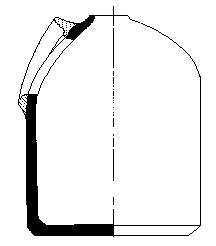
Recent discoveries made by Roger Hewitt on the probable site of a 17th Century glass house on the Isle of Wight may provide some interesting insights into the raw materials used then for glass making. Details are given on the Isle of Wight glass house page which can be accessed by clicking on the Isle of Wight on the map below.
Drinking glass is normally produced from glass melted in clay pots. Making these pots is still a major craft in itself, because of the high temperatures and the corrosive effects of the glass they have to withstand. As part of their drive to improve the quality of the glass they produced, 17th Century glass makers introduced covered pots. This prevented the glass from being contaminated by the effects of the furnace fire, but reduced the heat-transfer from the flames. It is not clear where or when these covered pots were introduced. The illustration shown here of a part-section through one is based on a reconstruction of the earliest one known. It was found on the site of the Bolsterstone Glasshouse in Yorkshire, and is discussed in Denis Ashurst's article in Volume 21 of the Post Medieval Archaeology Journal (1987).

It is possible that these covered pots were introduced early in the 1680s because a number of glass fragments have been found that date from this period where the type of glass decay is consistent with inadequate fusing during the glass making process.
|
|
The 'clickable' links opposite lead to pages describing what is known about individual glass houses that were probably making drinking glasses during the period. Links do not work if glass houses were not active in this period. |